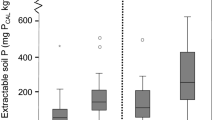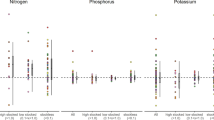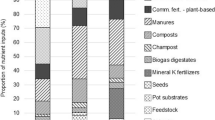Abstract
Effective nutrient management is essential in organic farming systems. Processed soluble fertilisers such as ammonium nitrate, which feed the plant directly and are thought to bypass the natural processes of the soil, are not generally acceptable. Nutrient supply to crop plants is supported through recycling, the management of biologically-related processes such as nitrogen fixation by clover and other legumes, and the limited use of unrefined, slowly-soluble off-farm materials that decompose in the same way as soil minerals or organic matter. The aim is to achieve as far as possible a closed nutrient cycle on the farm and to minimise adverse environmental impact. Effective management of any ‘waste’ materials such as manures and crop residues is a key to nutrient cycling on organic farms. However, not all organic farms have easy access to manures and recycling is limited by the prohibition of the use of sewage sludge because of current concerns over the introduction of potentially toxic elements, organic pollutants and disease transmission. In addition, the current global market, in which food is transported large distances from the farm, results in a significant export of nutrients. Exported nutrients must be replaced to avoid nutrient depletion of soils. Nutrient budgeting suggests some cause for concern over the sustainability of organic systems because of their dependence on feedstuffs and bedding for inputs of phosphorus (P) and potassium (K), and on the very variable fixation by legumes or imports of manure or compost for nitrogen (N); air pollution and net mineralisation from soil reserves appear to comprise a large part of the N supply on some organic farms. Losses of N from organic systems can also be as large as those from conventional systems and, being dependent on cultivation and the weather, they are even more difficult to control than those from fertilisers applied to conventional farms. There is some evidence of P deficiency in soils under organic production, and replacing K sold off the farm in produce is especially difficult. Organic farming systems may be sustainable and have the potential to deliver significant environmental benefits, but these depend on specific cropping and management practices on each farm. It is important that we study and improve nutrient management on all farm systems and in the context of plant, animal and human health in order to develop more sustainable farming systems.
Access this chapter
Tax calculation will be finalised at checkout
Purchases are for personal use only
Preview
Unable to display preview. Download preview PDF.
Similar content being viewed by others
References
Berry, P.M., Stockdale, E.A., Sylvester-Bradley, R., Philipps, L., Smith, K.A., Lord, E.I., Watson, C.A., and Fortune, S., 2002, N, P and K budgets for crop rotations on nine organic farms in the UK, Soil Use Manage. 18: 248–255.
Cooke, G.W., 1967, The Control of Soil Fertility, Crosby-Lockwood, London, 526p.
Cormack, W.F., 1999, Testing a stockless arable organic rotation on a fertile soil, in: Designing and Testing Crop Rotations for Organic Farming, J.E. Olesen, R. Eltun, M.J. Gooding, E.S. Jensen, and U. Kopke, eds., DARCOF, Denmark, pp. 115–124.
Fortune, S., Hollies, J., and Stockdale, E.A, 2004, Effect of different potassium fertilizers suitable for organic farming systems on grass/clover yields and nutrient offtakes and interactions with nitrogen supply, Soil Use Manage. 20: 403–409.
Fowler, S.M., Watson, C.A., and Wilman, D., 1993, N, P and K on organic farms: herbage and cereal production, purchases and sales, J. Agric. Sci. (Camb.) 120: 353–360.
Gerritse, R.G., and Vriesema, R., 1984, Phosphate distribution in animal waste slurries, J. Agric. Sci. (Camb.) 102: 159–161.
Goss, M.J., and Goorahoo, D., 1995, Nitrate contamination of groundwater: measurement and prediction, Fertil. Res. 42: 331–338.
Goulding, K.W.T., Stockdale, E.A., Fortune, S., and Watson, C., 2000, Nutrient cycling on organic forms, J. R. Agric. Soc. Eng. 161: 65–75.
Halberg, N., Kristensen, E.S., and Kristensen, I.S., 1995, Nitrogen turnover on organic and conventional mixed farms, J. Agric. Environ. Ethic. 8: 30–51.
Haraldsen, T.K., Asdal, A., Grasdalen, C., Nesheim, L., and Ugland, T.N., 2000, Nutrient balances and yields during conversion from conventional to organic cropping systems on silt loam and clay soils in Norway, Biol. Agric. Hortic. 17: 229–246.
Høgh-Jensen, H., Loges, R., Jørgensen, F.V., Vinther, F.P., and Jensen, E.S., 2004, An empirical model for quantification of symbiotic nitrogen fixation in grass-clover mixtures, Agric. Syst. 82: 181–194.
Howard, A., 1943, An Agricultural Testament, Oxford University Press, Oxford.
IFOAM (International Federation of Organic Agriculture Movements), 1998, IFOAM Basic Standards for Production and Processing, IFOAM Publications, Germany.
IFOAM (International Federation of Organic Agriculture Movements), 2006, http://www.ifoam.org/about_ifoam/principles/. Assessed October 2006.
Johnston, A.E., 1991, Potential changes in soil fertility form arable farming systems including organic systems, Proc. Fertil. Soc. Lond. 306: 38.
Johnston, A.E., Goulding, K.W.T., Poulton, P.R., and Chalmers, A.G., 2001, Reducing fertiliser inputs: endangering arable soil fertility? Proc. Int. Fertil. Soc. 487: 44.
Leach, K.A., Allingham, K.D., Conway, J.S., Goulding, K.W.T., and Hatch, D.J., 2005, Nitrogen management for profitable farming with minimal environmental impact: the challenge for mixed farms in the Cotswold Hills, England, Int. J. Agric. Sust. 2: 21–32.
Ledgard, S.F., and Steele, K.W., 1992, Biological nitrogen fixation in mixed legume/grass pastures, Plant Soil 141: 137–153.
Lockeretz, W., and Anderson, M.D., 1993, Agricultural Research Alternatives, University of Nebraska Press, Lincoln.
Lord, E., Stopes, C., and Philipps, L., 1997, Assessment of Relative Nitrate Losses from Organic and Conventional Farming Systems, based on Recent Measurements. Final Report to MAFF, Contract OFO 141, ADAS, Wolverhampton, UK.
Mäder, P., Fliessbach, A., Dubois, D., Gunst, L., Fried, P., and Niggli, U., 2002, Soil fertility and biodiversity in organic farming, Science 296: 1694–1697.
MAFF (Ministry of Agriculture, Fisheries and Food), 1999, Review of the Organic Aid Scheme, MAFF, London, UK.
Nolte, C., and Werner, W., 1994, Investigations on the nutrient cycle and its components of a biodynamically-managed farm, Biol. Agric. Hortic. 10: 235–254.
Olesen, J.E., Rasmussen, I.A., Askegaard, M., and Kristensen, K., 1999, Design of the Danish crop rotation experiment, in: Designing and Testing Crop Rotations for Organic Farming, J.E. Olesen, R. Eltun, M.J. Gooding, E.S. Jensen, and U. Kopke, eds., DARCOF, Denmark, pp. 49–62.
Paxton, A., 1994, The Food Miles Report: The Dangers of Long Distance Food Transport, SAFE Alliance, London, UK.
Peperzak, P., Caldwell, A.G., Hunziker, R.R., and Black, C.A., 1959, Phosphorus fractions in manures, Soil Sci. 87: 293–302.
Philipps, L., and Stopes, C.E., 1995, Organic rotations and nitrate leaching in the UK, Biol. Agric. Hortic. 11: 123–134.
Rajan, S.S.S., Watkinson, J.H., and Sinclair, A.G., 1996, Phosphate rocks for dirt application to soils, Adv. Agron. 57: 77–159.
RASE (Royal Agricultural Society of England), 2000, Shades of Green. A Review of UK Farming Systems, RASE, Stoneleigh, UK.
Rowe, J.S., 1997, From reductionism to holism in ecology and deep ecology, Ecology 27: 147–151.
Sato, S., Solomon, D., Hyland, C., Ketterings, Q.M., and Lehmann, J., 2005, Phosphorus speciation in manure and manure amended soils using XANES spectroscopy, Environ. Sci. Technol. 39: 7485–7491.
Scoones, I., and Toulmin, C., 1998, Soil nutrient balances: what use for policy? Agric. Ecosyst. Environ. 71: 255–267.
Silgram, M., and Shepherd, M.A., 1999, The effect of cultivation on soil nitrogen mineralisation, Adv. Agron. 65: 267–311.
Soil Association, 2004, Organic Food and Farming Report 2004, Soil Association, Bristol, UK.
Soil Use and Management, 2002, Soil Fertility in Organically Managed Soils, Vol. 18(Suppl.), pp. 238–308.
Stockdale, E.A., Shepherd, M.A., Fortune, S., and Cuttle, S.P., 2002, Soil fertility in organic farming systems – fundamentally different? Soil Use Manage. 18: 301–308.
Topp, C.F.E., Watson, C.A., Rees, R.M., and Sanders, I., 2005, The Prediction of Biological Nitrogen Fixation. XX International Grassland Conference: Offered Papers, Proceedings of the IGC, Dublin, Wageningen Academic Publishers, The Netherlands, 877p.
UKROFS, 1999, Standards for Organic Food Production, United Kingdom Register of Organic Food Standard, London, UK.
Watson, C.A., and Younie, D., 1995, Nitrogen balances in organically and conventionally managed beef production systems, in: Grassland into the 21st Century: Challenges and Opportunities, G.E Pollott, ed., Proc. Br. Grass. Soc. 1665: 197–199.
Watson, C.A., Fowler, S.M., and Wilman, D., 1993, Soil inorganic-N and nitrate leaching on organic farms, J. Agric. Sci. (Camb.) 120: 361–169.
Watson, C.A., and Atkinson, D., 1999, Using nitrogen budgets to indicate nitrogen use efficiency and losses from whole farm systems: a comparison of three methodological approaches, Nutr. Cycl. Agroecosyst. 53: 259–267.
Watson, C.A., Younie, D., and Armstrong, G., 1999, Designing crop rotations for organic farming: importance of the ley-arable balance, in: Designing and Testing Crop Rotations for Organic Farming, J.E. Olesen, R. Eltun, M.J Gooding, E.S. Jensen, and U. Kopke, eds., DARCOF, Denmark, pp. 91–98.
Watson, C.A., Bengtsson, H., Løes, A-K., Myrbeck, A., Salomon, E., Schroder, J., and Stockdale, E.A., 2002, A review of farm-scale nutrient budgets for organic farms in temperate regions, Soil Use Manage. 18: 264–273.
Willer, H., and Yussefi, M., 2005, The World of Organic Agriculture. Statistics and Emerging Trends 2005, IFOAM, Bonn, Germany.
Woodward, L., 2002, Science and Research in Organic Farming, EFRC Pamphlet series, Policy and Research Department, Elm Farm Research Centre, UK.
Author information
Authors and Affiliations
Editor information
Editors and Affiliations
Rights and permissions
Copyright information
© 2009 Springer Science+Business Media B.V.
About this chapter
Cite this chapter
Goulding, K., Stockdale, E., Watson, C. (2009). Plant Nutrients in Organic Farming. In: Kirchmann, H., Bergström, L. (eds) Organic Crop Production – Ambitions and Limitations. Springer, Dordrecht. https://doi.org/10.1007/978-1-4020-9316-6_4
Download citation
DOI: https://doi.org/10.1007/978-1-4020-9316-6_4
Publisher Name: Springer, Dordrecht
Print ISBN: 978-1-4020-9315-9
Online ISBN: 978-1-4020-9316-6
eBook Packages: Biomedical and Life SciencesBiomedical and Life Sciences (R0)




